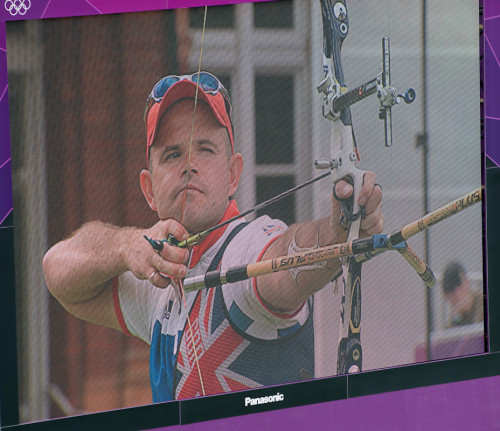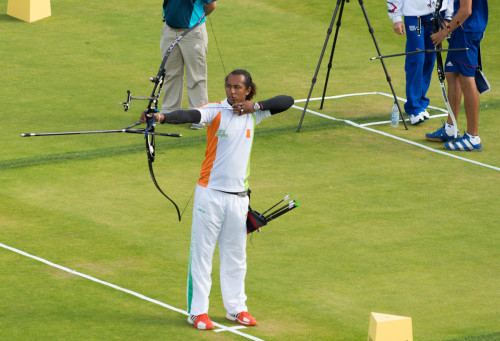Getting Into… Archery
It’s been a while since I last posted, and in that while I’ve travelled a bit. One of the places I passed through in my travels was London, and I was fortunate enough to pass through during the time of the Olympic Games. There is much to be written about the Olympic games, of course, but rather than dwelling on the awful commercialism, the errors in organizing, and doping controversies, I thought it might be better to write a little bit of a guide to some of the sports.
No doubt many viewers are exposed to sports which they don’t normally get to see. Big mainstream sports like football get plenty of TV coverage and in most countries opportunities to take up the sport are plentiful. The same can’t be said of some of the smaller sports, like archery. I happen to have some expertise in this particular sport and thought it might be interesting to give a little how-to guide for anyone considering taking up archery as a sport after watching it at the games.
Archery is relatively easy to take up if you know what you’re doing. Figuring this out can sometimes be a bit of a challenge. In most cases, the easiest way to get into it is to find an archery club. Why is this easier than getting a bow and setting up some targets in your back yard? For starters, a club will likely have some bows that you can borrow for some kind of trial period to see if you actually like the sport. Next, and probably most importantly, the club will probably have a handful of experienced archers who can teach you how to shoot properly. In archery, technique is everything. There is a nontrivial amount of physical conditioning required to compete at the highest level, but this is almost never a limiting factor in performance. Good technique and an ability to concentrate and focus for very long periods of time are skills which are highly-developed in an elite archer.
But what about those bows? You may ask. A competitor at the Olympics will typically have two identical setups. Bows which have a bewildering number of “bits” attached to them. Fortunately, Archery is nothing like triathlon in that past a certain point (generally, very early in an archer’s competitive career) it is impossible to “buy” better results. I am referring of course, to many a middle-aged triathlete with more money than cents who goes out and buys an expensive carbon fibre time trial bike with full disc wheels in an effort to better the personal best set in their first iron man triathlon. But I digress… below is a diagram of all of the components of a typical olympic recurve bow setup.
That’s it. There isn’t much more to it. The bit of the bow you hold onto is called the riser. The bits that bend and store potential energy before it is imparted to the arrow are called the limbs. The string is a fairly straightforward bunch of synthetic fibers (anything that doesn’t stretch when subjected to a pulling force all day) which are twisted to make the string more round. The nock point is there simply to ensure that the arrow is always nocked in the same place – consistency is the name of the game in archery. The sight is there to help you aim – ordinarily you line up the sight with the (blurry) string. The clicker is a device which you place over your arrows and “clicks” when the arrow is drawn back a certain length – once again ensuring that the length of the draw is consistent over every arrow. The stabilizer rods (center and side) are there to help balance the bow – they ensure that the center of mass of the whole bow is close to the handle so that when the string is released, there is no unpredictable movement coming from the rest of the bow.
You will also need an arm guard to stop the string from hitting your arm when released (this hurts a lot), and also a shoulder guard which prevents your clothing from catching the string as it is being released. Being an outdoor sport, sunglasses and a hat also come highly recommended, and the archer in the photograph above has both.
Strange Physics
Just before getting into the nitty-gritty of how to shoot, I think it’s worth mentioning a slightly unusual aspect of archery physics which has a dramatic effect on how you set up your bow. It’s called the “archer’s paradox”. For a right-handed shooter, the arrow rest on the riser is positioned on the left side. Why is that? Perhaps a diagram will help:
The red line represents the straight line which goes from the back of the string, through the center of your sight, and all the way to the middle of the target. In the first picture, the arrow is at rest, just before being fired. In the second picture the arrow has *just* been released. It bends slightly because… things bend slightly when you subject them to an accelerative force, especially things shaped like arrows. The reason it bends in that particular direction is because of the way the string comes out of the fingers of an archer’s right hand. The arrow wants to bend back, of course, and it does… and continues to bend more since it is still being accelerated by the bowstring. If the bow is set up correctly, it will reach the maximum bend in the other direction just as it is halfway past the riser (middle picture). As it continues on its flight, the bends back, *clearing* the bow, and continues to bend backwards and forwards all the way to the target. This is the paradox – a perfectly set-up bow will generally have the arrow pointed slightly off-line at full-draw. If you had been very observant, you will have noticed this in the slow-motion replay footage from the archery at the Olympics. Below is a video illustrating this in action.
Suffice to say that it is a difficult and complicated task to correctly set up a bow so that the arrow clears the bow consistently. Without a high-speed camera, it basically comes down to trial-and-error. An arrow that is too stiff won’t bend enough and will hit the riser as it goes through causing all kinds of unpredictable inconsistencies. The way the archer releases the string will have an impact on this. The weight (the force required to pull the bow to “full-draw”) of the bow will have an effect on how much the arrow bends. The weight of the metal point will have an effect, as will the length of the arrows.
Shooting
You put the arrow on the string, pull the string back, and let go. The trick is to do it exactly the same way every time. It’s best to begin shooting at a shorter distance, like 30m. At that distance, a terrible bow setup will still give you decent results as long as your technique is good. When aiming, the idea is to line up the center of the target with your sight and the string. In theory, this should ensure left-right consistency as long as you always release consistently. Up-down consistency is achieved by always drawing the arrow the same length. Begin by pulling the string back to the same point on your chin every time (this is called the “anchor point”). Some archers like to press the string against their noses for an additional anchor point, but this will largely depend on the shape of your face. The whole idea of the clicker is to make sure that you do this, but it is no guarantee. If you’re pulling the arrow back quickly, you’ll pull it through the clicker, the clicker will click, and you’ll react to it at some point after you hear the sound (usually a tenth of a second). If you pull the arrow back very slowly, all those things will happen at the same speed, which means that the distance past the clicker that you’ve pulled the arrow will be shorter, and your arrow will come out of the bow a little bit slower than if you had pulled it back quickly. You need to find a rhythm. This is very difficult when you’re concentrating on shooting, so to practice this, many professional archers shoot “bare bale” which is where they shoot at a target but without the target… often a bale of hay. Without the distraction of aiming, the archer can then concentrate on the rhythm of the shot.
Breathe. A lot of beginner archers hold their breath when they pull the arrow back – don’t do this. It is important to breathe. Breathe in, breathe out, pause here between breaths, and shoot inside that pause. It is also important to keep your teeth together with a gentle bite. This ensures that the anchor point on your chin is always in the same place. Stand up straight. Try to line everything up – target, sight, string, your back elbow. Keep your bow arm’s elbow slightly flexed (most people’s arms are perfectly straight only when the elbow is slightly flexed). If you find that you have a different eye-dominance to your preferred hand, it is generally better to shoot according to your eye dominance i.e. if you are left eye dominant, then you should shoot left-handed. Archery is a very relaxed sport, the finger-release must be relaxed to be consistent. In the book “Zen and the Art of Archery” by Eugen Herrigel he describes the string’s release like “a dewdrop rolling off a blade of grass”
Some final notes: archery is about consistency. It’s all about the “grouping” of your arrows – you can always adjust your sight to put your group in the middle, but if your group is too spread out, then it won’t help your score much. Most good risers will allow for a small amount of adjustment in the weight of the limbs. Use this to “tune” your bow so that your arrows come out cleanly. Do not be tempted to go up in weight. Sure, you won’t get far in competitive archery if your draw weight is less than 40 lb, but too many archers fall into the trap of trying to pull the fastest, heaviest bow that they can. A fast, well set-up bow can cover up for a lot of technique inconsistencies, but it will also cause you to fatigue sooner. A slow 10 is always worth more than a fast 9.
If you want to watch someone for technique Ki Bo Bae, the Korean girl who won the gold medal in the women’s individual has the best technique I’ve ever seen. The Koreans are consistently the strongest country in the world in archery, and most of the good equipment comes out of Korea. Archery doesn’t seem to favour any particular build although having big boobs would be a disadvantage (gets in the way of the string). Wide-set eyes and square jaws can help, as can having broad shoulders, but none of those attributes is essential. You do need to have good eyesight – if you wear glasses or contacts, make sure your prescription is correct.
Most importantly – have fun! Archery is a relaxing and rewarding sport. And just like most other sports, if you want to go to the Olympics, you’re going to have to practice… a LOT.





Leave a comment